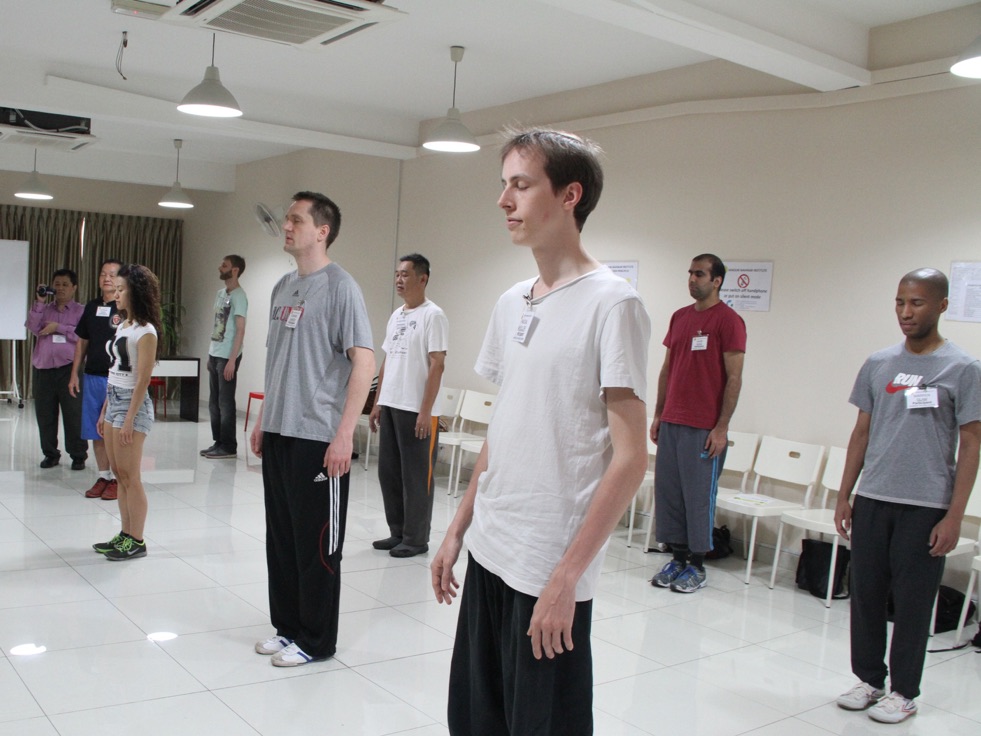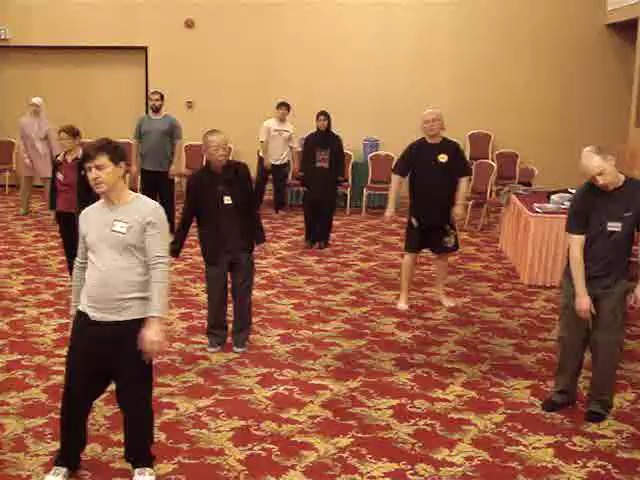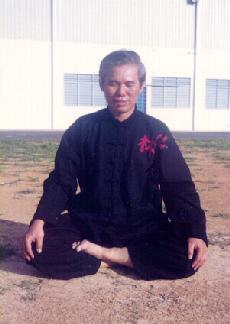SELECTION OF QUESTIONS AND ANSWERS
OCTOBER 2022 PART 2
Note
: The Q & A Series will end on Apr 25 Part 1, but the Series will carry on as usual.

Compassion is important in kungfu
Question 1
Andrew (Sifu Andrew Barnett of Switzerland) has suggested that compassion is a term rarely associated with the martial arts. What is the history of compassion in the Shaolin Wahnam martial arts? What benefits does this compassion have for the martial artist?
— Sifu Marc Harnish, Shaolin Wahnam Germany
Answer
Shaolin Wahnam is known for compassion, especially the ability to forgive. The Shaolin Monastery from which Shaolin Wahnam originated, was well known for compassion.
Compassion is for the person who shows compassion, though many people may not realize it. When we show compassion, like when we forgive, we are happy and more importantly we ensure our natural functioning, such as when we forgive we ensure natural functioning that can overcome diseases.
Martial artists today fight randomly usually discarding their own safety and becoming more unhealthy due to the injuries they have sustained. They forget that the main purpose of learning any martial art is to defend themselves or their loved ones, and to be healthy.
We aspire to the saying of "seng yeong" (Cantonese pronunciation), which means that you can cause injury or death if you want to. We learn not just kungfu, but also a very high level of kungfu. I remember very clearly that when I first taught kungfu to the public, many students suggested to me that I changed the name to advanced kungfu, but I told them that our kungfu was just the basic.
Question 2
Chris (Sifu Chris Didyk of the United States) has suggested that compassion is a weakness in combat. Why or why not?
Answer
To stop a few inches when we spar with an opponent in our kungfu practice does not mean that we are not compassionate. To be compassionate is different from to be humane. We may kill if we have to, such as preventing further suffering, but we remain humane.
But we practice kungfu for other reasons, especially for good health, vitality, longevity, peak performance and spiritual joys irrespective of religion. Kungfu starts when a person is healthy.
If he (or she) is sick, he should practice chi kung. The biggest group of people who wrote to thank me were not the people whom I had saved, but healthy people whose lives I have changed with zest and who lived every day with joy and happiness.

Chi kung state of mind
Question 3
Marc (Sifu Marc Harnisch of Germany) has suggested that each of our kungfu or Tai Chi set is complete in itself. The sets always include some techniques for building inner strength and generating a chi flow. Our chi kung is not only genuine, but also of a very high level.
Answer
We may classify genuine chi kung into three levels, namely physical, energy, and mind. Most people practice gentle, physical exercise though they call their art "chi kung". They just perform external chi kung techniques.
A good analogy is Taijiquan, spelt as Tai Chi Chuan in English. Practitioners just perform external techniques of Taijiquan, without the skills of generating energy flow to have internal force, and without the skills of fighting, which Taijiquan as a wonderful, internal martial art is to be.
Less than 20% of chi kung practitioners practice physical forms without breathing, and they usually practice at a low level. A few may practice breathing, such as Abdominal Breathing.
The most important is to enter a chi kung state of mind. It is a new term coined by the great chi kung master, Yan Xin, from China. It is known as entering a higher state of consciousness, or entering Zen in Shaolin, or entering Tao in Taijiquan. I learn it during my teaching, not during my student's days.
Some people practice meditation. The term "meditation" has become established, so we shall use it. A better term, although it is less known, is sitting silently or sitting Zen.
When meditators sit in a lotus position, myriad thoughts come to their mind, and they intellectialize. They are not in a chi kung state of mind.
We are at a very high level because we practice all the three dimensions of chi kung, i.e. the physical, energy and mind. When we practice the physical, we let our breathing be spontaneous; when we practice our breathing, we let the physical form be natural; when we practice meditation, we are relaxed and focused.
The techniques are important, but the skills when we are not initiated are more important. I clearly remember that my third sifu, Sifu Ho Fatt Nam, told me that if I were not relaxed and focused, i.e. in a chi kung state of mind, I might not practice any chi kung or kungfu.
We go to more advanced techniques as we progress. We practice Abdominal Breathing, Cosmos Breathing and Sinew Metamorphosis. We are at such a high level that we need to guard against over-training.
Question 4
Marc (Sifu Marc Harnish of Germany) suggests that we choose to follow the 10 Shaolin Laws. Why is it important for our personal development to be morally upright? How can the 10 Shaolin Laws help us in our personal development.
Answer
The 10 Shaolin Laws is a requirement. If anyone does not follow the 10 Shaolin Laws, he is not allowed to become a member of Shaolin Wahnam. The 10 Shaolin Laws are non-prohibitive. No one checks whether a Shaolin Wahnam member follows the Laws.
The 10 Shaolin Laws help us to be morally upright. It is worthwhile to note that morality is different from spirituality. Our proverbial example is a black magician. He is highly developed in spirituality or psyche, but bad in morals.
Hence, every time we practice chi kung or kungfu, we develop our morality and spirituality. We have to follow the 10 Shaolin Laws to be in Shaoin Wahnam, and we smile from the heart (which means the "mind" in classical Chinese), setting the spirit free.
The 10 Shaolin Laws give us tremendous benefits. One of the Laws advocates being kind to parents, which is good to ourselves, our parents and other people. Smiling from the heart sets our spirit free, which is the highest of all martial arts.
For convenience martial arts may be classified into three categories, namely mediocre, good and great. Shaolin Kungfu and Taijiquan are the greatest of all kungfu as they practice meditation directly.

Practicing chi kung
Question 5
Damian (Dr. Damian Kissey of Sabah, Malaysia) has suggested that there is scientific evidence of health benefits of practicing chi kung. Do you know any? If yes, please share and if no, please suggest how.
Answer
Chi kung, or "qigong" in Romanized Chinese, is the art of developing good health, vitality and longevity. High level chi kung develops peak performance and spiritual joys irrespective of religion.
But most people today practice gentle, physical exercise, and they don't know of it. It is because the external form is the same. In other words, it is skills and not techniques that are more important, especially those who are not initiated.
I learned this during my teaching days, and not when I was a student, though I had excellent teachers and I followed my teachers' instructions precisely.
The most important aspect is to enter into a chi kung state of mind, or a higher state of consciousness. If practitioners enter into a chi kung state of mind, they practice genuine chi kung. If they do not enter into a chi kung state of mind, they practice gentle, physical exercise.
It started in 1970s when chi kung masters taught chi kung in a package of a few months, as these masters could not stay long overseas. The students of these masters became chi kung teachers. But the essence of chi kung was lost. These chi kung teachers taught gentle, physical exercise thinking that it was chi kung.
Genuine chi kung contributes to good health, vitality and longevity. High level genuine chi kung contributes to peak performance and spiritual joys irrespective of religion.
Good health is regarded as the greatest wealth. If all our cells, tissues, organs and systems work the ways they are meant to work, the person will have good health. We call this harmonious chi flow, and chi kung promotes harmonious chi flow.
When we have harmonious chi flow, we will be full of life, or we have vitality. The excess chi will be stored in the side meridians and the wondrous eight meridians. The chi flow will go on for a very long time, as life is a meaningful flow of chi, or energy. In other words, we have longevity.
When we have abundant energy, more energy than to maintain life, it contributes to peak performance and spiritual joys irrespective of religion. We find every day a joy, and every day is a birthday.
Chi kung healing, which is very rare today, will be medicine of the future. Pharmaceutical companies and Western trained doctors can make sugar-coated pills instead of practicing chi kung, which takes a long time. They can be financially and spiritually wealthy.
Question 6
Best wishes from Wisconsin, USA! I am certain that everything is well with Sigung and his family in Malaysia.
— Andrew, USA
Answer
My family and I are doing well. It is true that if one is accomplished in the Shaolin arts, and our chi kung comes from Shaolin, it is better than changing stones to gold by touch.
I think fondly of the time in Galapagos and along the Western coast of the United States. It was a wonderful time we had.

Zen meditation
Question 7
I believe it's called "Hua Tou" in Chinese.
Answer
"Hua Tou" literally means "language head". It is very important in Zen Buddhism. The thought, like "Who am I" or "Who has these thoughts", is meant to bring about Cosmic Reality, or called the Original Face in Zen Buddhism.
Hua Tou, or Hua Tuo depending on which spelling system you use to describe Chinese names, lived about 140 to 208, and is regarded as the Sage or God of Chinese Medicine. He is famous for his Five-Animal Play, which is a set of chi kung exercises
Question 8
Lately I find that after my practice there is a heavy "negative" energy left in the room where I meditate. It feels like an entity that doesn't want to go away.
I feel that old energy, especially when I try to do chi kung, so I haven't been practicing much recently as it's not pleasant.
Answer
Our meditation is quite different from that of Vedanta tradition, though there are many similarities. You can try using the One Finger Zen hand form, the one you use in "One-Finger Shoot Zen", but use it as a last resort.
I once used it on a monster, a spiritual being much higher than a ghost or a nature spirit. The monster initially refused to leave the body of a student. I pointed my One Finger Zen hand form at the monster, and it fled away, never to be seen again. The One Finger Zen is very powerful, and it is the sign of Shaolin.
If there is negative energy near to where your mother, sister and young nephews live, a wise action is to move house. The native Indians lived there first, and thus had priority over the area. Tell your mother, sister and young nephews to move.
LINKS
Selected Reading
- Compassion and Enlightenment
- The Hallmark of Shaolin Kungfu are Compassion and Wisdom
- Spiritual Cultivation, Moral Education and Religious Development
- The Wonderful Benefits of Chi Kung
- Five-Animal Play and our Chi Flow
